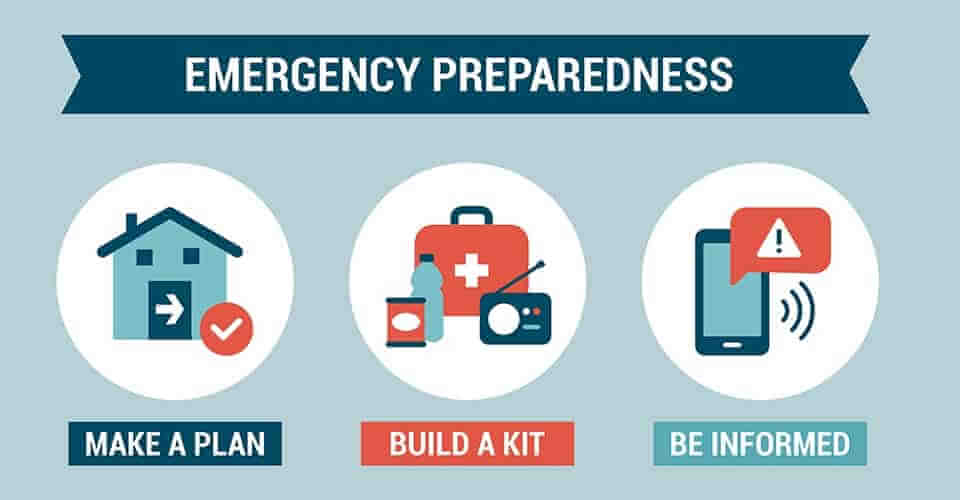I have been into emergency preparedness for over a decade.
More than ever before, the one thing I continue learning over and over again is that when the time for decision comes, the time for preparation has passed.
Procrastination is simply not an option when it comes to being prepared for an emergency. When we think of emergency preparedness, we usually consider having food storage and supplies on hand. This is important, and it is a great first step if you are just getting started. But equally as important to this is creating proper protocols for specific situations that are practiced often with you and your household members.
To more fully understand how important this is, let’s talk a little bit about how the human brain works.
The decision-making part of the brain is called the frontal lobe. When the frontal lobe is filled with adrenaline, you no longer have the ability to make decisions.
So when we feel the adrenaline from life-threatening or high-stress situations, our ability to clearly make decisions is impaired. You have probably experienced this in your life at some moment. If a dog is charging you with teeth bared, you do not have a clear and distinct thought process of exactly what you should do. You react almost unconsciously in a way that you hope will protect you.
This reaction is not our fault. It is how we are biologically wired.
Because we understand that it is difficult to make clear decisions in the moment of peer pressure or high stress, we start practicing with our elementary-aged children on how to prepare beforehand.
For example, the well-known DARE program implemented in fifth-grade classes throughout American teaches kids to “Just Say No to Drugs.” The creators of DARE know that practice is essential to preparedness, and so they ask children to practice over and over again saying “no.”
They do this in the hopes that in the moment of facing crucial decisions, these students have practiced enough to be able to make decisions aligned with their values and what is best for them.
 The examples, even from elementary school-aged children, are endless. Consider fire drills, lockdown drills, evacuations, and many other “practicing” type scenarios. These, along with the DARE program, are designed to push children’s decision making into the medial temporal lobe.
Because our decision-making is impaired in stress and our frontal lobe is no longer able to function well, we hope through these drills that these students will use the medial temporal lobe. This part of the brain is designed for processing memory.
Importantly, it is not affected by adrenaline in the same way the frontal lobe will be affected by adrenaline. This means that if you practice what you plan to do during an earthquake, you will have an easier time making the smartest decisions when that time comes because your practice is stored in your memory. Your brain is able to access memory, but not because you know what to do. Only because you have practiced what to do.
The decisions that we make in these critical moments could be the decisions that end up saving our lives.
The examples, even from elementary school-aged children, are endless. Consider fire drills, lockdown drills, evacuations, and many other “practicing” type scenarios. These, along with the DARE program, are designed to push children’s decision making into the medial temporal lobe.
Because our decision-making is impaired in stress and our frontal lobe is no longer able to function well, we hope through these drills that these students will use the medial temporal lobe. This part of the brain is designed for processing memory.
Importantly, it is not affected by adrenaline in the same way the frontal lobe will be affected by adrenaline. This means that if you practice what you plan to do during an earthquake, you will have an easier time making the smartest decisions when that time comes because your practice is stored in your memory. Your brain is able to access memory, but not because you know what to do. Only because you have practiced what to do.
The decisions that we make in these critical moments could be the decisions that end up saving our lives.
What Is An Emergency Protocol?
Just like the drills talked about above for school-aged children, we need to prepare for any emergency situation by doing our own type of “drills” as adults. These drills are called emergency procedure protocols. To create and practice an emergency protocol, pick an emergency that you or a loved one could possibly face. Next, consider what you would need in the case of this emergency and plan accordingly. (Often, this is in the form of food storage, first-aid kits, “ready to grab” bags, and drinking water.) After this, ask yourself basic questions about how you will communicate in the face of this emergency, how you will receive alerts and warnings, how you will evacuate, and how you will seek shelter. Consider writing the plan in a document, or drawing pictures for young children. Finally, practice the plan through your procedural protocol.This Protocol Should Be Practiced Often
To walk through an example of this, let’s consider a home fire. In the case of a home fire, we would want to make sure we have insurance in place, we would want to create a meeting place for our family members outside of our home, inform each child about primary and secondary evacuation routes, and discuss the best ways to avoid inhaling smoke. To follow through this protocol, you could have one night every few months where you spend an hour practicing. You could blow a whistle that signifies the start of the fire and have each family member follow their evacuation route. You could progressively make this more difficult by creating scenarios where the fire was more invasive and the evacuation more complicated. This emergency procedural protocol, specifically created by you and your family, will greatly increase the chances that in the case of a home fire, you and your loved ones would be safe. Many protocols for disasters will have overlap once you start diving into specifics. However, it is important to practice for specific situations even with this overlap, as our brains will have a higher chance of reacting to memory instead of reacting unconsciously.What Is An Emergency Action Plan?
An emergency action plan includes every part of your own specific emergency preparedness. To read more about what to include in your emergency action plan, read here. (Link to the previous article.)Who Needs An Emergency Action Plan?
Everyone needs an emergency action plan and emergency protocols, specific to their area and the risks they are most likely to face. As a starting point, pick a few disasters that could happen anywhere and to anyone, such as active shooters, home fires, and a pandemic. From here, start preparing for natural disasters that are most likely to happen in your area. Continue building your emergency action plan to be as all-encompassing and thoughtful as you can.When Is The Best Time To Practice Your Emergency Protocol?
Emergency protocols should be practiced often. If you have children, practice your emergency protocols every few months to keep their growing memories fresh. As your children age, practice once or twice yearly to refresh their memories. In addition, practicing emergency protocols when those in your household do not expect it can be extremely beneficial. Similarly to how the school will do fire drills that students know about and fire drills that students are unaware of, parents can best prepare for disasters by routinely practicing their emergency protocol before their children have had a chance to prepare. This way, parents can check for understanding and adjust their teaching accordingly.Related posts:
A Real-Life Example Of Why Emergency Preparedness Is So Important
How Do I Write An Emergency Disaster Plan?
Is All Emergency Food Storage The Same Thing in Different Packaging?
What Documents Should I Have On Hand In Case Of An Emergency?
The Ultimate Outdoor Survival Gear List
How To Clean Used 55 Gallon Barrels For Water Storage
How To Start Prepping For Beginners - A 10 Step Guide
How Can Individuals With Disabilities Prepare For Emergencies?


